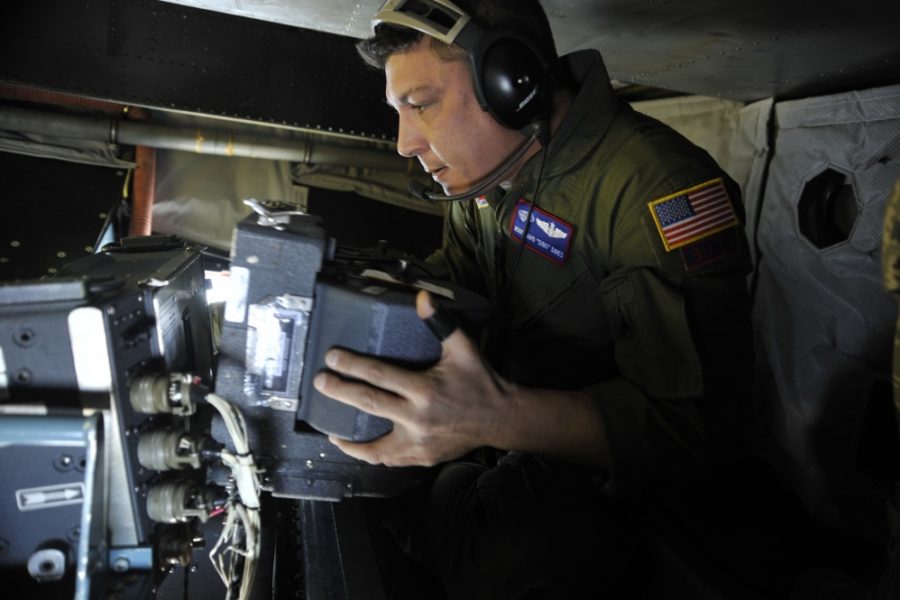Almost 20 years after countries began enforcing the Open Skies Treaty, the idea of using satellites to replace the Air Force’s decades-old OC-135B surveillance airplanes is gaining new life in Washington. But is it feasible?
The treaty allows about three dozen signatory nations to fly over other countries to monitor their domestic military operations and, occasionally, local developments like natural disasters. America’s two OC-135B jets were equipped with wet-film cameras to take photos of foreign land, but are now switching to digital cameras and are in the early stages of being replaced by newer planes. Both are housed at Offutt AFB, Neb.
The challenges of maintaining nearly 60-year-old aircraft, a standoff with Moscow over Russian sensor upgrades and behavior during flights, and improved satellite imagery capabilities are driving the treaty’s critics to call for a new way forward. Critics say new electro-optical sensors give Russia an unfair advantage, which the US should use satellites to offset. Others note that the resolution of Moscow’s cameras fall within the treaty’s parameters, are commercially available, and could be matched by American camera upgrades in the works.
“The President should withdraw from the Open Skies Treaty and redeploy the hundreds of millions of dollars the Pentagon wastes on the flights and equipment to increase US combat power,” Sen. Tom Cotton (R-Ark.) said on Twitter in October.
Can satellites handle the job instead? Some experts say yes, but relying on space-based assets may not be the smartest approach.
Satellites have long been part of the Open Skies conversation. In written testimony submitted in November for a House Foreign Affairs Committee hearing on the treaty, Amy Woolf, a nuclear weapons expert at the Congressional Research Service, noted that at the Senate’s hearings on treaty ratification in 1992, officials agreed the US and Russia’s reconnaissance satellites already offered information on foreign military forces and infrastructure.
Flying overhead wouldn’t provide much more detail for those advanced countries, they said, but the treaty would still offer a new level of transparency and stability.
“While nations that lacked satellite capabilities would benefit most from the information collected during Open Skies flights, the United States would benefit from the improved security environment in Europe,” Woolf wrote.
Security concerns have changed in Europe, another factor that is driving the push toward satellites. Some analysts say that despite Russia’s continued aggressions, “there is little risk of war among most nations in Europe,” Woolf wrote. “They argue that US satellite capabilities, along with other sources of data and intelligence, can monitor military deployments that threaten the rest of Europe.”
Those analysts now argue that commercial satellite and open-source intelligence could collect data that is similar to what comes out of observation flights, she added.
The treaty allows countries to collect images with a resolution up to 30cm, a clarity that commercial remote sensing satellites now provide, according to Todd Harrison, an aerospace expert at the Center for Strategic and International Studies. Commercial synthetic aperture radar satellites also offer better resolutions than what Open Skies allows.
Melissa Hanham, a nuclear and open-source intelligence expert at the One Earth Future Foundation, said that while satellites are more capable than ever before, all space sensors could instead fly closer to land on aerial platforms, so planes offer higher-quality images. Other countries can also reap the benefits of overflights, letting them keep an eye on geopolitical neighbors and rivals themselves instead of relying on other countries for information.
“Satellites do have a great use when planes aren’t flying, and offer a consistent view over time of potential changes,” she said.
Analysts who support the treaty disagree that satellite and open-source data would offer the full scope of coverage that is useful to the US, especially if the satellites don’t send back images focused on areas that interest treaty participants. Countries may also doubt whether commercial satellites are giving them accurate information, Woolf wrote.
“There is a risk that these images might be altered in ways that could exacerbate, rather than mitigate, misperceptions,” she said.
Supporters also point out that the Open Skies Treaty offers opportunities for people from around the world to interact with each other, building trust and strengthening military partnerships. That helps US participants get a better sense of what’s going on overseas on a human level.
“We [the 32 countries that aren’t Russia or Belarus] get to hang out with Russian officers almost weekly, and feel out how things are going over there,” Steffan Watkins, a Canadian expert on the treaty, said. “Are they unusually tense? Are they mellow? This provides invaluable information.”
Harrison argues that the US could retire its Open Skies aircraft—an idea some lawmakers have resisted—but remain in the treaty. That way, other countries would still reap the benefits of transparency and international cooperation, and the US could use foreign aircraft to perform Open Skies flights.
Operating and maintaining the OC-135B is relatively expensive, he said, while the cost of pulling photos from military and intelligence community space systems that are already in the inventory is “essentially zero because we are presumably collecting this imagery already.”
“In many ways, I think the Open Skies Treaty has been overtaken by technology,” he said. “It mainly serves to benefit countries that don’t have the same space-based capabilities as the United States and Russia, but advances in commercial satellite systems are further leveling the playing field.”
Watkins said buying and launching additional satellites to perform the Open Skies mission would exceed the cost of flying, maintaining, and replacing the OC-135B. He added that the idea of instead using satellite imaging is a distraction while the treaty’s opponents try to convince the Trump administration to leave the pact despite opposition from international allies.
“It’s not about catching [another country] doing something at that moment,” Watkins said. “It’s about capturing imagery to confirm a suspicion and have incontrovertible proof by using a camera/sensor and handling procedures that everyone has agreed [are] tamper-proof.”
